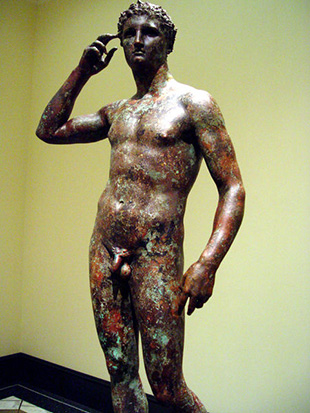












Common bronze alloys have the unusual and very desirable property of expanding slightly just before they set, thus filling the finest details of a mold.
The strength and lack of brittleness (ductility) of the material is an advantage when figures in action are to be created, especially when compared to various ceramic or stone materials. These qualities allow the creation of extended figures, as in Jeté, or figures that have small cross sections in their support, such as the equestrian statue of Richard the Lionheart, both shown to the right. The value of the bronze for other uses is disadvantageous to the preservation of bronze sculptures; few large ancient bronzes have survived as during wartime many were melted down to make weapons or to create new sculptures commemorating the victors, while a far larger portion of contemporary stone and ceramic sculptures have survived, even if only in fragments subsequently reassembled.
The great civilizations of the old world worked in bronze for art, from the time of the introduction of bronze for edged weapons. The Greeks were the first to scale the figures up to lifesize. Very few examples exist in good condition of these cast works. The seawater-preserved bronze now called "The Victorious Athlete" is a fine example but painstaking efforts were required to bring it to its present state for museum display. Far more Roman bronze statues have survived. The ancient Chinese, from at least 1200BC, knew both lost wax casting and section mould casting, and in the Shang dynasty created many large ritual vessels covered with complex decoration which have survived in tombs. Over the long creative period of Egyptian dynastic art, small lost wax bronze figurines were made in large numbers and several thousand of them have been conserved in museum collections. From these beginnings, bronze art has continued to flourish up to the present.
By Appointment
DE FERRANTI
South Park Studios - Suite 10
88 Peterborough Road, London SW6 3HH
United Kingdom